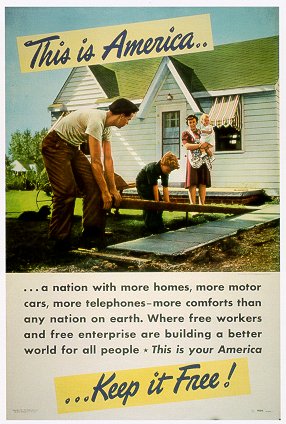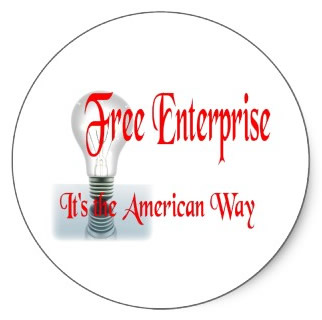 In 1947 the Ad Council launched a nationwide public ‘education’ campaign to sell the free enterprise system to the American people. The program was to operate at three levels:
In 1947 the Ad Council launched a nationwide public ‘education’ campaign to sell the free enterprise system to the American people. The program was to operate at three levels:
Details of the plant level programs were to be largely determined by the individual corporations concerned, with the Joint Committee of the Advertising Council acting in a supervisory capacity. The national advertising campaign was to be coordinated by the Advertising Council.
The Ad Council received ‘unprecedented amounts of money’ from business toward the $100 million economic education campaign ‘to ‘sell’ the American economic system’ to the public, including $100,000 donations from General Foods and General Electric. General Motors, IBM, Johnson and Johnson, Procter and Gamble, Goodrich, Republic Steel all supported the campaign financially and various advertising agencies offered free services. The campaign started with over $3 million worth of donated time and space from the media and advertising agencies.
According to Ken Wells, Director of Operations of the Advertising Council’s Program on Economic Understanding, what was needed was:
A driving, hard-hitting ten-year campaign to sell and tell, and keep understood and sold, the positive and worthwhile principles of the American way… Our job is putting the easily teachable definition of the economic system between the ears of 143,000,000 Americans.
According to the Council these ‘principles of the American way’ were:
 The free market was described as ‘the most democratic institution ever devised by man—whereby all the people decide every day what goods and services are to be produced and in what quantities, making their decisions by establishing the prices they are willing to pay’. Competition was depicted as constantly forcing ‘the seller to keep improving the goods and services he offers’. Government was supposed to be ‘an authority which referees the game but does not play in it, enforces the rules but does not direct the play.’
The free market was described as ‘the most democratic institution ever devised by man—whereby all the people decide every day what goods and services are to be produced and in what quantities, making their decisions by establishing the prices they are willing to pay’. Competition was depicted as constantly forcing ‘the seller to keep improving the goods and services he offers’. Government was supposed to be ‘an authority which referees the game but does not play in it, enforces the rules but does not direct the play.’
Ironically the individualist message of competition and self interest was sold through a campaign that sought to promote industrial harmony and the idea that we should all cooperate and work together to protect the system and achieve the prosperity it promised. The campaign explained why ‘freedom and security go together’ and argued that prosperity could be achieved by free enterprise and increased production through mechanisation and better efficiency and the cooperation of workers and management. The Ad Council used token union support and the endorsement of the presidents of the AFL and the CIO to prove it was non-partisan. The campaign was also cheered on by Dwight D. Eisenhower both before and after he became president.
The nationwide advertising campaign was launched in October 1947 and the New York Times reported that it ‘has stirred an enthusiasm that promises to make it a new weapon against Communist aggression… Radio stations have pledged time for full-length dramatizations, the outdoor and car-card advertising industries have agreed to provide large space, as have leading Sunday newspaper supplements, business magazines and house organs. Value of the facilities is more than $1,000,000.’
By October 1947, some 5,000 business, community and educational organisations had been issued with a ‘Plan for Action’ kit. This kit was designed by the Ad Council Joint Committee and a team of advertising agencies. The kit included a ‘blueprint’ which set out directions for the ‘simple presentation of free enterprise fundamentals’ aimed at teaching the value of the free enterprise economy and industry’s role in it.
As part of the ‘plant level program’ 9 million employees were put through ‘evangelical’ anti-union, anti-government courses of ‘economic education’ within a three year period.
In June 1949, Ken Wells, operations director for the Joint Committee, estimated that the plant and community programs ‘combined with the advertising prepared for this phase of the campaign by the Advertising Council’ had ‘reached, to a greater or lesser extent, about 70 per cent of the American population’.
Business executives were also trained at intensive one-week seminar courses called Freedom Forums which began in 1949. The first of these was described by an insider:
Over 100 important people from American industry journeyed to this small town to sit through long sessions of indoctrination in the fundamentals of our economic system and to discuss the most effective channels of communication needed to give an understanding of America to those who are confused or apathetic.
There they were taught about the free enterprise system and ‘came away considerably more informed, and with a new and dynamic articulateness’ according to Wells, who himself went on to become executive vice-president of the Freedom Foundation that had just been formed.
In the first two years of the Ad Council campaign, 600 pages of ads had been published at no cost, newspapers had printed 13 million of lines of advertising for free, 8000 billboards had been erected, and radio messages were being broadcast into ‘almost every home in America’. The advertisements offered a free pamphlet ‘The Miracle of America’ and 1.5 million copies of this were distributed by 1950. Many more had been reprinted in magazines and company publications.
By the end of 1949, the Advertising Council’s campaign had blanketed the country with over 500 advertisements in national magazines, newspaper supplements and business publications, 8,000 newspaper advertisements, 6,000 outdoor posters and messages carried by almost all the network radio programs resulting in more than 2 billion ‘listener impressions’.